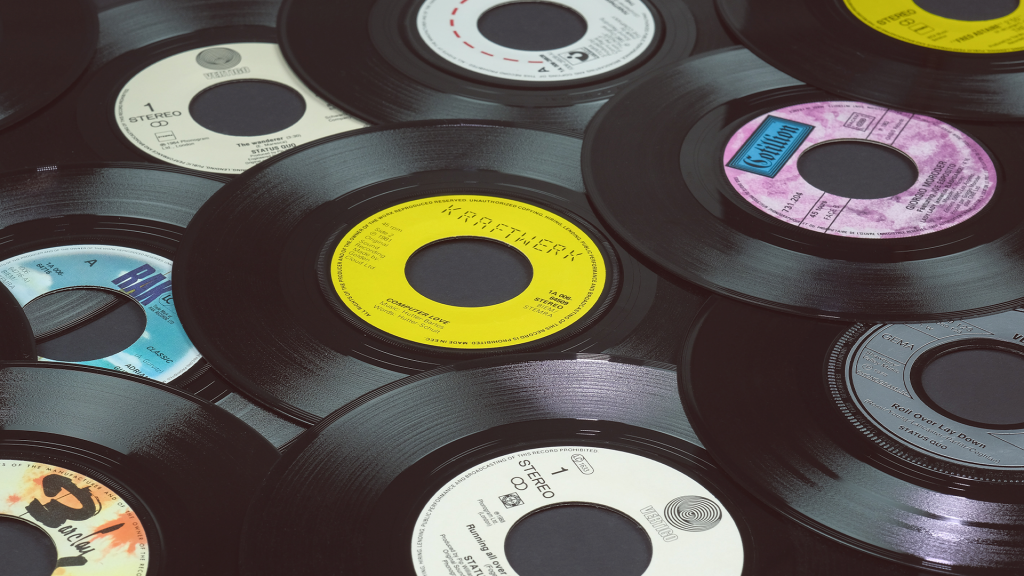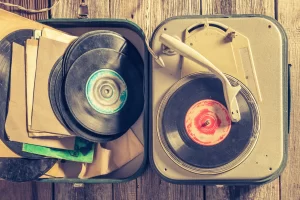In the world of music, trends come and go, but vinyl records have proven to be an enduring medium that has outlasted many of its successors. This blog post will delve into the fascinating renaissance of vinyl, a phenomenon that has seen these retro music carriers make a remarkable comeback in the 21st century.
Vinyl records, first introduced in the late 19th century, were once the primary medium for listening to recorded music. However, with the advent of CDs in the 1980s, followed by digital music in the early 2000s, vinyl seemed destined to become a relic of a bygone era. Yet, contrary to all predictions, vinyl has not only survived but has enjoyed a significant resurgence in popularity.
This post will explore the journey of vinyl from its near extinction to its current revival. We’ll look at why and how this resurgence began, what makes vinyl appealing in today’s digital age, and how this trend is impacting the music industry. We’ll also gaze into the crystal ball to speculate on what the future might hold for vinyl.
Whether you’re a long-time vinyl enthusiast, a recent convert, or simply curious about this unexpected revival, we invite you to join us on this exploration of the return of retro. This is the story of the renaissance of vinyl.
The Decline of Vinyl
The decline of vinyl records began in the mid-1980s with the advent of compact discs (CDs). CDs offered a more portable, durable, and convenient way to listen to music. They were smaller, easier to store, and didn’t degrade with repeated use, unlike vinyl records which could scratch easily and lose sound quality over time. The digital format of CDs also meant that music could be copied without any loss in fidelity, opening up new possibilities for sharing and distributing music.
In addition to CDs, cassette tapes also played a role in the decline of vinyl. Despite their inferior sound quality compared to vinyl, cassettes were even more portable and convenient than CDs. They were particularly popular for use in cars, where their small size and lack of skipping made them an ideal medium for mobile music consumption.
By the late 1990s, the rise of digital music and the internet had further eroded the market share of vinyl. Services like Napster allowed users to share digital music files freely over the internet, while devices like the iPod made it easy to carry thousands of songs in your pocket. The convenience and accessibility of digital music seemed to mark the final nail in the coffin for vinyl.
However, while vinyl records were being pushed out of the mainstream, they never completely disappeared. A dedicated core of audiophiles and collectors kept the format alive, cherishing the unique sound quality and tactile experience of vinyl. These enthusiasts would become the seed for vinyl’s eventual resurgence.
The Resurgence of Vinyl
At the dawn of the new millennium, when digital music seemed to have claimed an unassailable dominance, something unexpected happened – vinyl began to make a comeback. The resurgence didn’t happen overnight; it was a gradual process that started around the mid-2000s and has been gaining momentum ever since.
One of the key factors contributing to the resurgence of vinyl was a growing sense of nostalgia. As digital media became ubiquitous, many people began to long for the tactile experience of physical media. The act of dropping a needle on a record, the large album covers with their artwork and liner notes, the ritual of flipping a record mid-way through – these were all experiences unique to vinyl that no digital format could replicate.
Another crucial factor was sound quality. While digital music is technically superior in terms of clarity and precision, many music lovers argue that vinyl offers a warmer, more authentic sound. The slight crackles and pops, the rich tones, and the overall “analog” feel of vinyl records provide a listening experience that is distinctly different from digital music.
This resurgence of vinyl is reflected in sales figures. According to the Recording Industry Association of America, vinyl record sales have been growing consistently year on year, with a staggering 29.2% increase in 2020 alone. In fact, vinyl sales even surpassed CD sales for the first time since the 1980s.
The return of vinyl is not just a trend, but a testament to the timeless appeal of this medium. It’s a reminder that in our fast-paced digital world, there’s still room for slower, more tactile experiences that engage our senses in a way that digital media simply can’t.
The Appeal of Vinyl in a Digital Age
In an era dominated by digital music streaming, the appeal of vinyl may seem counterintuitive. Yet, there are several reasons why vinyl records have found a place in the hearts of music lovers in the 21st century.
Firstly, there’s the sound quality. While digital music offers crystal clear sound, many argue that it lacks the warmth and depth of vinyl records. The analog nature of vinyl captures the nuances of the music in a way that digital formats often miss. The slight imperfections, the soft crackles, and the rich tones all contribute to an audio experience that feels more authentic and personal.
Secondly, there is something inherently satisfying about the tactile nature of vinyl. In a world where music is often consumed passively, the act of playing a vinyl record is a ritual. It requires active engagement – from choosing the record, to placing it on the turntable, to gently dropping the needle on the groove. This process fosters a deeper connection between the listener and the music.
Thirdly, vinyl records offer a visual and physical experience that digital media can’t replicate. Album art is a significant part of the music experience, and vinyl records, with their large covers, provide a canvas for artwork that is much more impactful than the tiny thumbnail images on digital platforms.
Lastly, owning a vinyl record is about possession and collectability. In the digital age, music has become ephemeral and intangible. Owning a vinyl record, on the other hand, gives one a sense of permanence and ownership. The act of adding a new record to your collection, organizing them, and displaying them is a pleasure in itself.
All these factors combine to make vinyl a uniquely appealing medium for music in the digital age. It’s not just about listening to music, but experiencing it in a profound and meaningful way.
The Impact on the Music Industry
The resurgence of vinyl records has had a significant impact on the music industry. For one, it has created a new revenue stream for artists and record labels. In an era where digital streaming revenues are often criticized for being too low, the relatively high profit margins on vinyl records have been a welcome boost.
According to the Recording Industry Association of America, in 2020, vinyl sales generated more revenue than CDs for the first time since the 1980s. This is a clear indication that the vinyl revival is not just a passing fad but a substantial shift in consumer behavior.
The vinyl resurgence has also breathed new life into independent record stores. These shops, which were once on the verge of extinction due to the rise of digital music and big-box retailers, have found a new lease of life. They have become cultural hubs for music lovers, offering a sense of community and a place to discover new music that is often lacking in digital platforms.
Furthermore, the popularity of vinyl has encouraged a renewed focus on audio quality in music production. Artists and producers are increasingly recognizing that the unique sound qualities of vinyl can offer a different listening experience, leading them to consider this medium during the recording and mixing process.
However, the vinyl resurgence also presents challenges. The demand for vinyl records has outpaced supply, leading to long wait times for new releases. There’s also the environmental impact to consider, as vinyl records are made from PVC, a non-biodegradable plastic.
Overall, the vinyl revival is reshaping the music industry in surprising ways. It’s a testament to the enduring power of music and the diverse ways people choose to enjoy it.
Looking Ahead: The Future of Vinyl
As we look ahead, it’s clear that vinyl has carved out a distinct niche in the music market. While digital streaming continues to dominate, vinyl records have emerged as a significant player, appealing to both older audiences who remember the format from its heyday and younger listeners who are drawn to its tactile and analog qualities.
However, the future of vinyl will not be without its challenges. The industry will need to address issues such as production bottlenecks and environmental concerns associated with PVC. New technologies, such as HD Vinyl, which uses laser-cutting technology to produce records that promise higher audio quality and are more environmentally friendly, could play a role in the evolution of the medium.
Moreover, the vinyl industry will need to continue to innovate and adapt to maintain its appeal. This could involve exploring new formats, enhancing the retail experience, or leveraging technology to bridge the gap between the analog and digital worlds.
At the same time, the industry should focus on what makes vinyl unique: the ritualistic experience, the physicality, and the rich sound. These are the attributes that will continue to attract music lovers and ensure vinyl’s place in the music ecosystem.
While it’s impossible to predict the future with certainty, one thing is clear: vinyl records, once written off as relics of a bygone era, have proven their resilience. They’ve made an impressive comeback in the face of digital domination, and there’s every reason to believe they will continue to thrive and evolve in the years to come.
To Sum it Up
In conclusion, the resurgence of vinyl in the digital age is a fascinating study of how nostalgia, combined with a desire for tangible, high-quality experiences, can lead to a product’s revival. Even as digital music platforms provide convenience and an endless library of songs at our fingertips, the appeal of vinyl records underscores the fact that music lovers still value the physicality, superior sound quality, and ritualistic experience associated with this medium.
The vinyl revival has had a substantial impact on the music industry, providing artists and record labels with a profitable revenue stream and breathing new life into independent record stores. However, it has also presented challenges, including production bottlenecks and environmental concerns. As we look to the future, the industry will need to address these issues through innovation and adaptation.
Despite these challenges, the future of vinyl looks promising. With new technologies emerging and a dedicated fan base, vinyl records are likely to continue to hold a special place in the music ecosystem. They bring a unique, immersive listening experience that digital music platforms cannot replicate.
The story of vinyl’s comeback reminds us that in our fast-paced, digitally dominated world, there remains a place for analog experiences that engage our senses and create lasting memories. It’s not merely about the music; it’s about the experience, the connection, and the joy of owning something tangible. That’s the enduring allure of vinyl in a digital age.




